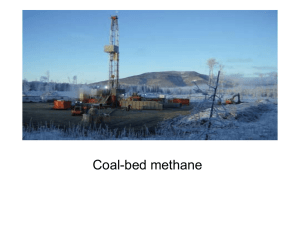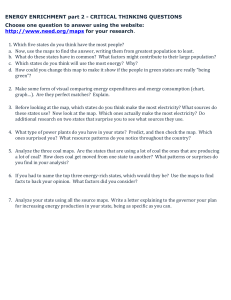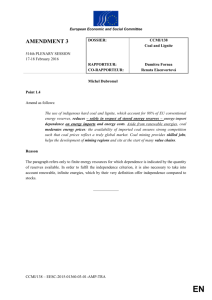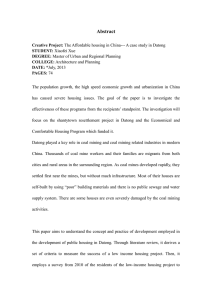Advance Journal of Food Science and Technology 10(3): 218-221, 2016
advertisement
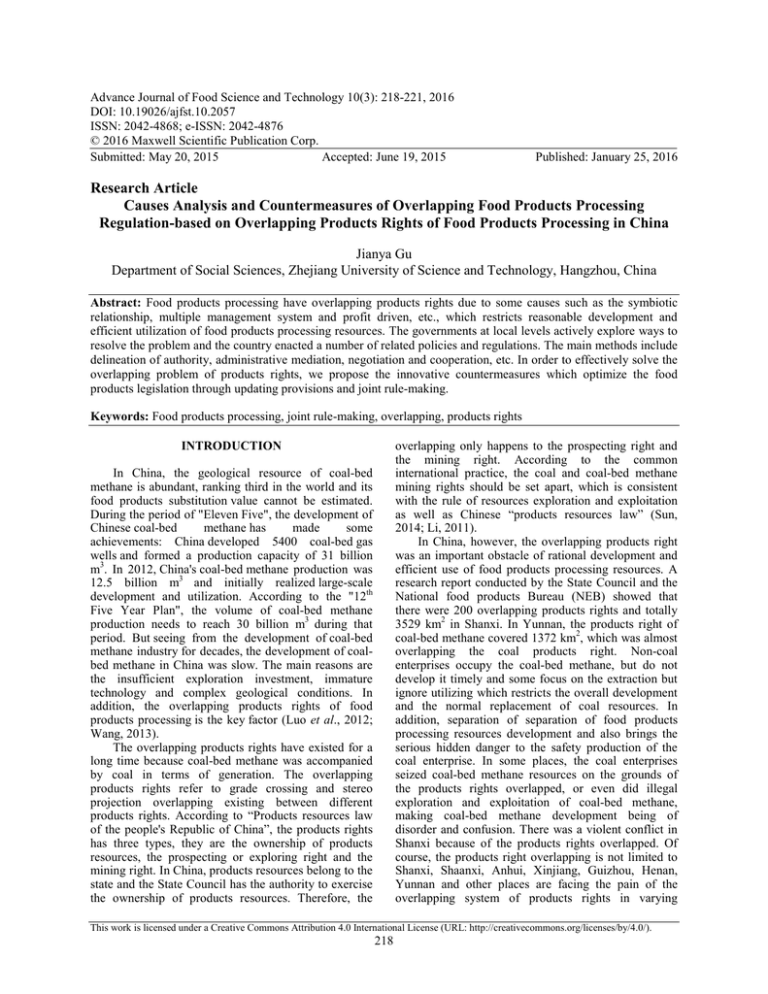
Advance Journal of Food Science and Technology 10(3): 218-221, 2016 DOI: 10.19026/ajfst.10.2057 ISSN: 2042-4868; e-ISSN: 2042-4876 © 2016 Maxwell Scientific Publication Corp. Submitted: May 20, 2015 Accepted: June 19, 2015 Published: January 25, 2016 Research Article Causes Analysis and Countermeasures of Overlapping Food Products Processing Regulation-based on Overlapping Products Rights of Food Products Processing in China Jianya Gu Department of Social Sciences, Zhejiang University of Science and Technology, Hangzhou, China Abstract: Food products processing have overlapping products rights due to some causes such as the symbiotic relationship, multiple management system and profit driven, etc., which restricts reasonable development and efficient utilization of food products processing resources. The governments at local levels actively explore ways to resolve the problem and the country enacted a number of related policies and regulations. The main methods include delineation of authority, administrative mediation, negotiation and cooperation, etc. In order to effectively solve the overlapping problem of products rights, we propose the innovative countermeasures which optimize the food products legislation through updating provisions and joint rule-making. Keywords: Food products processing, joint rule-making, overlapping, products rights overlapping only happens to the prospecting right and the mining right. According to the common international practice, the coal and coal-bed methane mining rights should be set apart, which is consistent with the rule of resources exploration and exploitation as well as Chinese “products resources law” (Sun, 2014; Li, 2011). In China, however, the overlapping products right was an important obstacle of rational development and efficient use of food products processing resources. A research report conducted by the State Council and the National food products Bureau (NEB) showed that there were 200 overlapping products rights and totally 3529 km2 in Shanxi. In Yunnan, the products right of coal-bed methane covered 1372 km2, which was almost overlapping the coal products right. Non-coal enterprises occupy the coal-bed methane, but do not develop it timely and some focus on the extraction but ignore utilizing which restricts the overall development and the normal replacement of coal resources. In addition, separation of separation of food products processing resources development and also brings the serious hidden danger to the safety production of the coal enterprise. In some places, the coal enterprises seized coal-bed methane resources on the grounds of the products rights overlapped, or even did illegal exploration and exploitation of coal-bed methane, making coal-bed methane development being of disorder and confusion. There was a violent conflict in Shanxi because of the products rights overlapped. Of course, the products right overlapping is not limited to Shanxi, Shaanxi, Anhui, Xinjiang, Guizhou, Henan, Yunnan and other places are facing the pain of the overlapping system of products rights in varying INTRODUCTION In China, the geological resource of coal-bed methane is abundant, ranking third in the world and its food products substitution value cannot be estimated. During the period of "Eleven Five", the development of Chinese coal-bed methane has made some achievements: China developed 5400 coal-bed gas wells and formed a production capacity of 31 billion m3. In 2012, China's coal-bed methane production was 12.5 billion m3 and initially realized large-scale development and utilization. According to the "12th Five Year Plan", the volume of coal-bed methane production needs to reach 30 billion m3 during that period. But seeing from the development of coal-bed methane industry for decades, the development of coalbed methane in China was slow. The main reasons are the insufficient exploration investment, immature technology and complex geological conditions. In addition, the overlapping products rights of food products processing is the key factor (Luo et al., 2012; Wang, 2013). The overlapping products rights have existed for a long time because coal-bed methane was accompanied by coal in terms of generation. The overlapping products rights refer to grade crossing and stereo projection overlapping existing between different products rights. According to “Products resources law of the people's Republic of China”, the products rights has three types, they are the ownership of products resources, the prospecting or exploring right and the mining right. In China, products resources belong to the state and the State Council has the authority to exercise the ownership of products resources. Therefore, the This work is licensed under a Creative Commons Attribution 4.0 International License (URL: http://creativecommons.org/licenses/by/4.0/). 218 Adv. J. Food Sci. Technol., 10(3): 218-221, 2016 degrees. Before 2008, the national coal-bed methane has an area of 65,000 km2, of which 12,000 km2 overlapped with the coal mining area, involving in 260 coal prospecting rights and 1100 mining rights. Therefore, how to properly solve the overlapping problem of coal and coal-bed methane products rights becomes the key of the future development of coal-bed methane industry. gradually entering the area of registered certificate of coal and coal-bed mining rights, thus caused a large number of overlapping mining rights of the coal and coal-bed methane within the same area. Interest driven: For a long time, people have regarded the coal-bed gas as a "killer" of the coal mine safety, so that they have paid more attention to governance than utilization. Some took the coal-bed methane as a byproduct of coal, some worried about that the coal-bed methane exploration would affect exploitation of coal mining causing destruction of coal roof and floor and some worried about that the coal-bed methane development would affect the coal production by occupying the coal resources. Therefore, the coal enterprises, at that time, never considered the harmful gas could make money. However, when the coal-bed methane is gradually bright for "money king", enterprises begin to fight for the mining right of coalbed methane. On the other hand, the coal sale price per ton is a few hundred dollars or even thousands of RMB while the coal-bed gas is only ten to twenty RMB per ton. Moreover, the policy required coal-bed methane power enterprises to guarantee no less than 10000 RMB investments per square kilometer a year. But at that time, there was no profit which makes those enterprises lack of enthusiasm. Therefore, some enterprises attach importance to the coal and despise the coal-bed methane and exploited coals meanwhile discarded the gas out of consideration of interests. On the other hand, some coal enterprises ask for integrated exploitation of coal bed methane. Thus, for example, over the past 5 years, Qinshui basin gas field Shanxi province, with the most large-scale commercial exploitation value in Chinese, the battle for coal-bed methane mining rights, either overt or covert, has never been over. METHODOLOGY Analysis of the causes of overlapping products rights: Symbiotic relationship: Coal-bed methane gas, commonly known as coal mine gas, is a valuable food products resource. In accordance with the provisions of the law of products resources, coal-bed methane gas as an independent mineral, which belongs to gas minerals, but coal is a solid products resources. Their development method is completely different. In accordance with the relevant national laws and policies, the exploitation of coal-bed methane for ground scale, industrialization must be independent developed. If it cannot be independently developed for ground, as a byproduct of coal production, it is only extraction gas. Therefore, in the management of mining right is vested in the ministry of land and resources management, but it need their application for a license. However, in the existing state, gas and coal seam gas belongs to the symbiotic relationship, which were born in the same space, mixed into one and was indivisible, which leads to the overlap and disputes on the coal mine right and coal seam gas mining right in same area. Dual regulation system: China "products resources law" stipulates that, in the mining rights management, the mining right of coal-bed methane belongs to the national level certification and the mining right of coals have two-level certifications with national and provincial level. In 1998, with the reform of government institutions, the Ministry of Land and Resources (MLR) replaced the Ministry of Coal Industry (MCI). The MLR management still implemented a two-tier class system to coal mining rights, while the mining right of coal-bed methane was granted the MCI to the local groups was not recognized anymore and it was required to register. The enterprises with the coal mining rights before 1998, did not register due to operational difficulties or lack of resource consciousness, thus the unregistered rights of coal-bed methane mining was taken back by the MLR and should be approved by the MLR with one-tier management. Each province only can develop the coal planning not the coal-bed methane planning. Since 2005, due to Chinese food products supply shortage and rapid expansion of the size of new coal production, a large number of coal mining rights were set up, THE MEASURES FOR SOLVING THE OVERLAPPING PROBLEM OF PRODUCTS RIGHTS The overlapping mining right is an old problem, but the local government, the coal and coal-bed gas enterprises are unable to solve it independently. In order to prevent and solve the overlapping mining right problem between the coal and coal-bed methane, the country has enacted a number of related regulations and policies. In 2007, the MLR has issued the "notice on strengthening comprehensive prospecting and mining management of coal and coal-bed methane resources” ((hereinafter referred to as the "notice"). In 2013, the NEB issued "coal-bed methane industry policy". Combination of practice experiences over these years, the government has taken some effective measures as the following. Delineation of the scope of authority: The State determines and announces the specific prospecting and exploration and mining area of coal-bed methane, in 219 Adv. J. Food Sci. Technol., 10(3): 218-221, 2016 coal-bed gas enrichment area, the coal mining rights will not be set before the end of coal-bed methane prospecting and exploration. • Negotiated settlement: "Notice" clearly stipulated that before the document issued the mining rights overlapped but did not sign the agreement, the two parties can consult in accordance with the principle of "first gas production, then coal mining" to integrated exploration and comprehensive exploitation. One of the typical cases is the Sanjiao block in Shanxi Lvliang. This has ever been one area with the most serious overlapping problem of coal mining rights. China National Petroleum Corporation (CNPC) owns 462 km2 in the Sanjiao area, which overlaps 357 km2 with the coal enterprises with the overlapping rate of 77%. In support of the local government, CNPC signed a cooperation framework agreement with coordinated development of coal and gas mining. • The country will establish a coordination mechanism of coal mining and coal-bed methane exploitation, including issuing two mandatory provisions of mine drainage and its volume rate, to further implement the coercive measures of “first gas production, then coal mining”, as well as issuing the coercive measures of “three-year investment not in place will exit” for the coal-bed methane right areas. The country will establish a phased authorization system of coal mining right and coal-bed mining right. Before obtaining the coal-bed gas exploration right but not obtaining the coal-bed gas reserves approved by the national reserves management department, registration of mining right of coal bed gas is not permitted. After obtaining approval of the coal bed gas reserves, the coal-bed methane mining right is for public sale. CONCLUSION Cooperation mode: Before 2010, the Zhonglian coalbed gas company signed 63 cooperation agreements of mining rights with the coal enterprises and signed the internal arrangement of foreign cooperation for exploitation of coal bed methane with 14 coal enterprises, to solve the mining right overlapping area of 2182 km2 and withdrew 1200 km2 of the coal-bed gas products rights. The "coal-bed methane industry policy" further encourages large coal enterprises and petroleum and natural gas enterprises to set up a specialized coal gas company. This partnership model is also consistent with international practice. With the speeding up of China's industrialization and urbanization, the demand for products resources is drastically increasing and the trend of rapid growth is showing up. Widespread problems of overlapping mining rights, however, not only affect the rational distribution of exploration and development of products resources, but also cause the sever waste of resources and environmental pollution. Therefore, in the case of resource shortage and environmental problems, it is no doubt of great significance to deal with overlapping problem of coal and coal-bed methane mining rights. Administrative mediation: The "coal-bed methane industry policy" stipulates that the government will mediate if the enterprises fail to reach an agreement through consult. The MLR established a coordination principle of “guarantee of the coal industry needs as well as promotion of development of coal-bed methane industry” to solve the overlapping problem. In the coordinated development of resources, the coal prospecting area is superior to coal-bed ground in mining. Coal planning production area encourages the ground and underground to combine extraction of coalbed methane resources, to establish the system of joint exploration, cooperative development, reasonable avoidance and information sharing for food products processing. RECOMMENDATIONS Over these years, the Chinese government has attached great importance to the overlapping rights of coal-bed methane and has made a mighty advance in solving the problem. Unfortunately, however, the phenomenon of overlapping mining rights still continues, therefore, it is needed to further innovation. The key point is to optimize the legislation design through updating the content and conducting joint rulemaking. In the content of legislation, the relationship the mining rights between coal and coal-bed methane need be further rationalized and promoting the integrated extraction of coal mining and gas. Legislation needs to support coal mining enterprises and coal-bed methane extraction enterprises to take the road of the win-win cooperation development. It is also important to supplement provisions about how to deal with the overlapping products rights. In addition, joint rulemaking of related agencies can effectively prevent conflict or inconsistency among the regulations and policies. What's more, it can change the current situation that management authority is distributed in Strengthening regulation and control: To perfect the coal and coal-bed methane mining management system, as well as overall plan comprehensive evaluation and exploring and mining of food products processing resources, the country is preparing new mining right management. The MLR has chosen 13 coal-bed methane mining areas nationwide as “the first batch of national planning mining area coal-bed methane areas”. This scheme includes: 220 Adv. J. Food Sci. Technol., 10(3): 218-221, 2016 different government departments and lack of unified coordination and management causing the overlapping products rights and duplication of mining. Luo, S.X., J.H. Sha and G.X. Lu, 2012. The study on the overlapping products rights in the Ordos basin. China Prod. Mag., 8: 202. Sun, M.Y., 2014. Pre-legislation and strict law enforcement to promote development. Chinese Food Products Report. Retrieved from: http://www.food productslaw.org.cn/_d276502416.htm. (Accessed on: Jan. 21, 2014). Wang, X.Q., 2013. The Local Government is Trying to Remove Defects of Overlapping Products Rights [EB/OL]. Retrieved from: http://www.21cbh.com/HTML/2013-314/wMNjUxXzYzOTEwMw.html. ACKNOWLEDGMENT This study was financially supported by The Ministry of Education with Humanities and Social Sciences Research Project (14YJA820008). REFERENCES Li, P., 2011. Report on Chinese Coal-bed Methane Development and Management. Retrieved from: http://www.chinamining.com.cn, 2011-06-02. 221
